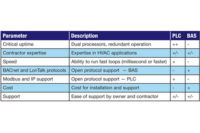Bringing FDD information from HVAC equipment into the BAS provides building owners with the ability to see and solve problems before they result in problems related to comfort, performance, and efficiency.
Our expectation today for all unitary, and for more and more applied equipment, is that it will come with some form of integrated controls as part of the packaged equipment. These control packages range from being fairly rudimentary to being very advanced and tightly integrated. The movement to the use of open systems such as BACnet and LonMark make integrating these systems into a BAS fairly easy and economical. When we integrate these systems, the focus is typically on getting the same type of data that we would get from a field-applied controller. Any additional data, such as FDD information, is also nice to have, but it often varies significantly from supplier to supplier and is hard to specify. However, this may be about to change.
Recent changes approved for the California State Energy code (Title 24) will now require that all rooftop units above 4.5 tons will come with FDD starting in 2014. The requirements focus on the issues related to the unit economizer, since this has been identified as one of the major failure points for this type of equipment. The information from the FDD needs to be communicated to services personnel (i.e., through the BAS) or to the local thermostat. Granted, this is a requirement in only one state and for one system type, but expect that FDD will soon become more readily available as suppliers provide products to meet these requirements.
Ideally, delivery of FDD will allow for BAS to transition from providing data (e.g., alarms) to actionable information, which can be used for improved operations and efficiency. ES




